- HELP
- Technical Information
- CNC Turning
- Applicable Parts/Materials
- Material Properties
Material Properties
Ferrous Metals
Material – Features
| Material | Features |
|---|---|
| 1018 Carbon Steel | A rolled steel material widely used for general structural applications. The name is derived from its tensile strength of 400 N/mm^2 or higher. It is characterized by low cost and good workability and is used in a wide range of industries including machinery and construction. |
| 1045 Carbon Steel | A structural carbon steel containing approximately 0.45% carbon. It is relatively easy to machine and can be heat treated (quenching, etc.) to improve strength and wear resistance. It is often used in mechanical parts such as shafts, gears, and pins. |
| 4135 Alloy Steel | An alloy steel containing chromium and molybdenum with high strength and toughness. Heat treatment can improve its strength and wear resistance and it is easily hardened. It is often used for mechanical parts like high-strength bolts, shafts, and gears. |
| 4140 Alloy Steel | A material that combines high strength and toughness. It can be Heat treated (quenching, etc.) to improve strength and wear resistance. It is used for products that require both strength and durability and is often used in the automotive and mechanical parts industries. |
| O1 Tool Steel | A cold work alloy tool steel with high hardness, high wear resistance, and relatively good toughness. It is often used in cold mold parts such as shear blades, punches, dies, gauges, etc. |
| D2 tool steel | A type of alloy tool steel featuring high hardness and wear resistance. Strength and wear resistance can be improved with heat treatment (quenching, etc.). Although lower than stainless steel, its corrosion resistance is still relatively high. It is often used for molds, jigs, gauges, and other products that require hardness and wear resistance. |
| H13 tool Steel | A hot work alloy tool steel containing chromium, molybdenum, and vanadium. It maintains strength even in high heat and is resistant to thermal fatigue and cracking. Heat treatment by quenching and tempering improves durability and dimensional stability. |
| 52100 alloy Steel | A high-carbon, chromium bearing steel with very high hardness and wear resistance. It is easily hardened and is suitable for precision applications such as bearings, rollers, gauges, and mechanical components. |
Material Properties *The following values are for reference only and are not guaranteed.
| Material | Tensile strength (N/mm2) | Yield (N/mm2) | Elongation at Break % | Flexural strength (N/mm2) | Compressive strength (N/mm2) | Yield point (N/mm2) | Young’s Modulus (N/mm2) | Flexural modulusa (N/mm2) | Specific Gravity | Electrical Conductivity (S/m) | Thermal Conductivity (W/m・K) | Coefficient of Linear Expansion (/℃) |
|---|---|---|---|---|---|---|---|---|---|---|---|---|
| 1018 Carbon Steel | 400~510 | 215~355 | 21 or more | 360~485 | 380~485 | 245~355 | 2.0×10⁵ | 2.0×10⁵ | 7.87 | 6.96×10⁶ | 58 | 11.7×10⁻⁶ |
| 1045 Carbon Steel | 570~750 | 330~490 | 20 or more | 600 | 600 | 330~490 | 2.0×10⁵ | 2.0×10⁵ | 7.87 | 6.0×10⁶ | 45 | 11.9×10⁻⁶ |
| 4135 Alloy Steel | 900~1050 | 750~900 | 15 or more | 950 | 950 | 750~900 | 2.1×10⁵ | 2.1×10⁵ | 7.85 | 6.0×10⁶ | 42 | 11.0×10⁻⁶ |
| 4140 Alloy Steel | 950~1100 | 800~950 | 12 or more | 1000 | 1000 | 800~950 | 2.1×10⁵ | 2.1×10⁵ | 7.85 | 6.0×10⁶ | 42.7 | 11.0×10⁻⁶ |
| O1 Tool Steel | 1000~1300 | 850~1100 | 10 or more | 1100 | 1100 | 850~1100 | 2.1×10⁵ | 2.1×10⁵ | 7.85 | 4.5×10⁶ | 25 | 12.2×10⁻⁶ |
| D2 tool steel | 1800~2000 | 1500~1700 | 5 or more | 1900 | 1900 | 1500~1700 | 2.1×10⁵ | 2.1×10⁵ | 7.8 | 4.0×10⁶ | 20 | 12×10⁻⁶ |
| H13 tool Steel | 1200~1400 | 1000~1200 | 10 or more | 1300 | 1300 | 1000~1200 | 2.1×10⁵ | 2.1×10⁵ | 7.73 | 4.0×10⁶ | 25 | 13.3×10⁻⁶ |
| 52100 alloy Steel | 1570~1960 | 700~850 | 10 or more | 900 | 900 | 700~850 | 2.1×10⁵ | 2.1×10⁵ | 7.8 | 6.0×10⁶ | 46.6 | 12.5×10⁻⁶ |
Aluminum
Material – Features
| Material | Features |
|---|---|
| 2017 Aluminum Alloy | Also known as “Duralumin”, this aluminum alloy has excellent machinability and strength. Due to its copper content, it has lower corrosion resistance than other aluminum alloys. It is widely used in aircraft and vehicle components due to its excellent strength. |
| 5056 Aluminum Alloy | A high magnesium content aluminum alloy with excellent corrosion resistance, strength, and weldability. It is widely available as a round bar material. It has good extrusion properties, and is often used for structural materials, frames, supports, etc. |
| 6061 Aluminum Alloy | An aluminum alloy with enhanced corrosion resistance and heat treatment properties. Its corrosion resistance is one of the highest among aluminum alloys. The T6 temper (artificial aging heat treatment) provides high tensile and yield strength. It is often used in outdoor and harsh saltwater or chemical environments. |
| 7075 Aluminum Alloy | Also known as “super duralumin” this aluminum alloy is both high strength and light weight. It has excellent heat treatment properties. Its strength and impact resistance are among the highest among aluminum alloys. It is an ideal material for applications that require a high strength to weight ratio. |
Material Properties *The following values are for reference only and are not guaranteed.
| Material | Tensile strength (N/mm2) | Yield (N/mm2) | Elongation at Break % | Flexural strength (N/mm2) | Compressive strength (N/mm2) | Yield point (N/mm2) | Young’s Modulus (N/mm2) | Flexural modulusa (N/mm2) | Specific Gravity | Electrical Conductivity (S/m) | Thermal Conductivity (W/m・K) | Coefficient of Linear Expansion (/℃) |
|---|---|---|---|---|---|---|---|---|---|---|---|---|
| 2017 Aluminum Alloy | 390~500 | 250~350 | 10~18 | 450 | 450 | 250~350 | 7.2×10⁴ | 7.2×10⁴ | 2.79 | 2.0×10⁷ | 130 | 23.6×10⁻⁶ |
| 5056 Aluminum Alloy | 290~350 | 200~270 | 10~20 | 320 | 320 | 200~270 | 7.0×10⁴ | 7.0×10⁴ | 2.66 | 2.5×10⁷ | 130 | 23.8×10⁻⁶ |
| 6061 Aluminum Alloy | 260~310 | 240~270 | 8~15 | 280 | 280 | 240~270 | 6.9×10⁴ | 6.9×10⁴ | 2.7 | 2.5×10⁷ | 167 | 23.6×10⁻⁶ |
| 7075 Aluminum Alloy | 510~580 | 430~500 | 7~12 | 550 | 550 | 430~500 | 7.1×10⁴ | 7.1×10⁴ | 2.8 | 2.0×10⁷ | 130 | 23.6×10⁻⁶ |
Stainless Steel
Material – Features
| Material | Features |
|---|---|
| 303 Stainless Steel | An austenitic stainless steel with improved machinability and workability. It maintains high corrosion resistance and strength while offering excellent machinability, making it suitable for complex machine components. Corrosion resistance and weldability are lower than 304SS. It is often used for single parts such as bolts and shafts. |
| 304 Stainless Steel | An austenitic stainless steel with improved corrosion resistance and weldability. It is a versatile widely available material used in various industries. Because of its excellent weldability, high corrosion resistance and strength, it is often used for facilities, equipment, and machinery. |
| 316 Stainless Steel | An austenitic stainless steel with improved corrosion and pitting resistance compared to 304SS. It is suitable for harsh environments exposed to salt water and chemicals. Often used when corrosion may lead to critical failures. |
| 440C Stainless Steel | The highest hardness stainless steel. Heat treatment (quenching) provides high strength, hardness, and wear resistance. It is suitable for mechanical and precision parts that require durability and is often used for bearings, shafts, pins, tool parts, mold parts, etc. |
Material Properties *The following values are for reference only and are not guaranteed.
| Material | Tensile strength (N/mm2) | Yield (N/mm2) | Elongation at Break % | Flexural strength (N/mm2) | Compressive strength (N/mm2) | Yield point (N/mm2) | Young’s Modulus (N/mm2) | Flexural modulusa (N/mm2) | Specific Gravity | Electrical Conductivity (S/m) | Thermal Conductivity (W/m・K) | Coefficient of Linear Expansion (/℃) |
|---|---|---|---|---|---|---|---|---|---|---|---|---|
| 303 Stainless Steel | 520~750 | 205 or more | 40~60 | 600 | 600 | 205~310 | 1.93×10⁵ | ≈1.93×10⁵ | 7.93 | 1.4×10⁶ | 16.2 | 17.3×10⁻⁶ |
| 304 Stainless Steel | 520~750 | 205 or more | 40~60 | 600 | 600 | 205~310 | 1.93×10⁵ | ≈1.93×10⁵ | 7.93 | 1.4×10⁶ | 16.2 | 17.3×10⁻⁶ |
| 316 Stainless Steel | 520~700 | 205 or more | 40~60 | 580 | 580 | 200~300 | 1.93×10⁵ | ≈1.93×10⁵ | 7.98 | 1.3×10⁶ | 13 | 15.9×10⁻⁶ |
| 440C Stainless Steel | 1900~2100 | 1500 or more | 5~10 | 2000 | 2000 | 1500~1700 | 2.0×10⁵ | ≈2.0×10⁵ | 7.7 | 0.8×10⁶ | 24 | 10.2×10⁻⁶ |
Copper & Brass
Material – Features
| Material | Features |
|---|---|
| Brass C3604-LCd | An alloy of copper and zinc known as brass. Compared to C2801, it requires less cutting force and chips break more easily during machining. It is more suitable for precision components than C2801. |
Material Properties *The following values are for reference only and are not guaranteed.
| Material | Tensile strength (N/mm2) | Yield (N/mm2) | Elongation at Break % | Flexural strength (N/mm2) | Compressive strength (N/mm2) | Yield point (N/mm2) | Young’s Modulus (N/mm2) | Flexural modulusa (N/mm2) | Specific Gravity | Electrical Conductivity (S/m) | Thermal Conductivity (W/m・K) | Coefficient of Linear Expansion (/℃) |
|---|---|---|---|---|---|---|---|---|---|---|---|---|
| Brass C3604-LCd | 335~540 | 270~410 | ≥10 | ー | 400~450 | ー | 96000 | 1.0×10⁵ | 8.43 | 1.51×10⁷ | 117 | 20.5×10⁻⁶ |
Resin
Material – Features
| Material | Features | Appearance |
|---|
| Acetal (standard, white) | An engineering plastic known as POM or Delrin. It has high mechanical strength, wear resistance and chemical resistance. It has excellent machinability and low cost. Compared to MC nylon, it has lower water absorption and higher wear resistance. It has excellent dimensional stability over long-term use. |  |
| Acetal (standard, black) | 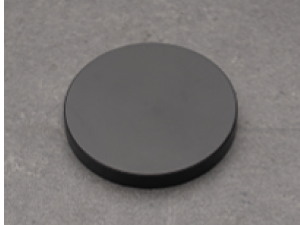 |
|
| MC Nylon (standard, blue) | Provides excellent mechanical strength, chemical resistance (except strong acids), thermal properties, and wear resistance. Due to its high water absorption, dimensional stability is relatively poor. | 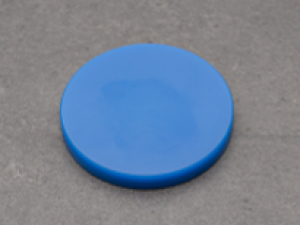 |
| MC Nylon (weather resistance, black ash) | A weather resistant grade of MC nylon that resists deterioration to exposure in outdoor environments. Dimensional changes may occur due to its water absorption if used in a wet environment. |  |
| MC Nylon (Anti-static, black) | A grade of MC Nylon with increased electrical conductivity and a volume resistivity of 1~100Ω・m. Due to its inherent water absorption, dimensional changes may occur in wet environments. It is more expensive than anti-static MC Nylon. | 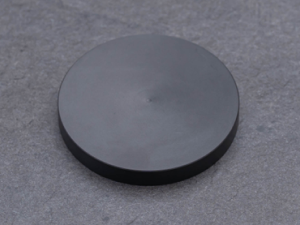 |
| MC Nylon (Conductivity, black) | A grade of MC Nylon that prevents static electricity buildup. The volume resistivity is 10~1000kΩ・m, which is higher than that of conductive MC nylon. It is also cheaper than conductive MC nylon. Dimensional changes may occur due to its water absorption if used in a wet environment. | 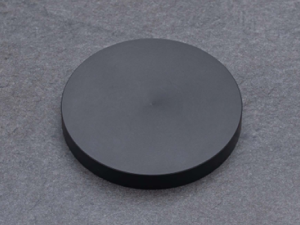 |
| ABS (standard, natural color) | A cost-effective resin with excellent mechanical strength and particularly high impact resistance and shock absorption. It has excellent machinability and can be bonded. | 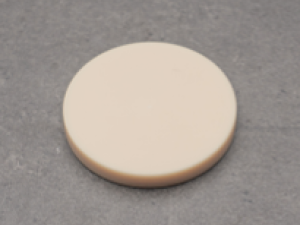 |
| ABS(standard, black) | 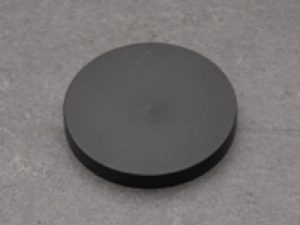 |
|
| PEEK (standard, gray-brown) | A thermoplastic with the highest heat resistance and mechanical strength. It has very high dimensional stability, chemical resistance, and wear resistance. It is resistant to most acids, bases, and organic solvents, even at high temperatures. It is also an expensive material. | 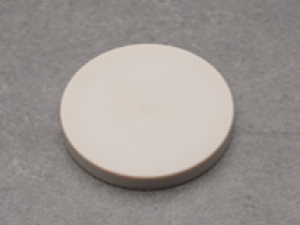 |
| PPS (standard, natural color) | A super engineering plastic with excellent heat resistance, dimensional stability, chemical resistance, mechanical strength, and wear resistance. It is resistant to most chemicals below 200°C and has similar heat resistance as PEEK but with a lower price. It has low water absorption and thermal expansion and has excellent dimensional stability. |  |
| Acrylic(standard, transparent) | A plastic with very high light transmittance used in displays, lighting covers, interiors, etc. It is vulnerable to petroleum-based solvents and alkaline chemicals. Machined surfaces have reduced transparency. | 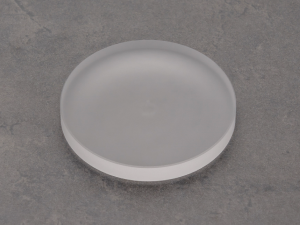 |
| PC(standard, transparent) | A plastic with excellent impact resistance, heat resistance, and dimensional stability. It has high light transmission and is used for covers, window materials, and protective panels. It also has good machinability and can be used for machine parts. | 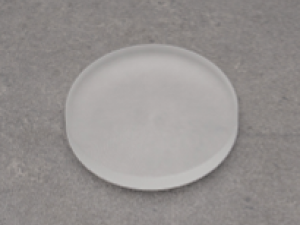 |
| PC(standard, black) | 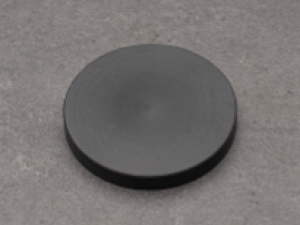 |
|
| PP(standard, natural color) | A lightweight plastic with excellent chemical resistance, water resistance, insulation, high heat resistance, and a natural color. It is used in mechanical parts, pipe components, insulation materials, etc. It has good machinability and is low cost. | 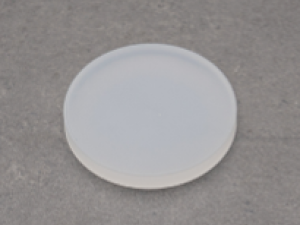 |
| PVC(standard, gray) | A gray colored vinyl chloride resin, with excellent chemical resistance, water resistance, and electrical insulation. It is rigid, has high dimensional stability, good machinability, and is used in pipe parts, housings, insulation materials, etc. | 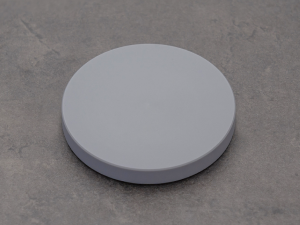 |
| UHMWPE (standard, white) | A polyethylene with a molecular weight of more than 1 million g/mole. It has low specific gravity, high wear resistance, shock absorption, low friction, and is lower cost than PTFE. It has high thermal expansion and poor dimensional stability. It has a rough surface finish and is difficult to remove burrs from edges. | 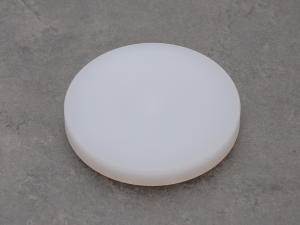 |
| PTFE (standard, white) | A type of fluoropolymer that has very high heat resistance, chemical resistance, and cold resistance as well as low friction. It has low hardness compared with other resins and is prone to burrs. Can be used at a wide range of temperatures but high thermal expansion causes the volume to change greatly with temperature. Dimensional stability is poor. It is suitable for environments exposed to chemicals and high-temperature. | 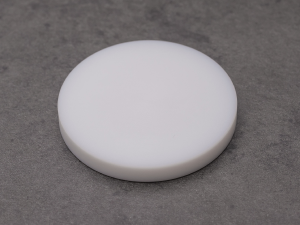 |
Material Properties *The following values are for reference only and are not guaranteed.
| Material | Tensile strength (N/mm2) | Flexural strength (N/mm2) | Elongation at Break % | Young’s Modulus (N/mm2) | Rockwell hardness | Specific Gravity | Continuous use temperature ℃ |
|---|---|---|---|---|---|---|---|
|
60~68 | 89~108 | 40~75 | 2988 | R118 | 1.41 | 95~100 |
| MC Nylon (standard, blue) | 96 | 110 | 30 | 3432 | R120 | 1.16 | 120 |
| MC Nylon (weather resistance, black ash) | 83 | 110 | 40 | 3334 | R120 | 1.16 | 120 |
| MC Nylon (Anti-static, black) | 75 | 118 | 7 | 2500~2700 | R117 | 1.23 | 120 |
| MC Nylon (Conductivity, black) | 69 | 118 | 10 | 2500~2700 | R119 | 1.2 | 120 |
|
39~54 | 64~81 | 18 | 1900~2800 | R105~115 | 1.05 | 60~95 |
| PEEK (standard, gray-brown) | 98~116 | 170~175 | 20~40 | 4200~4345 | M100-120 | 1.32 | 250~260 |
| PPS (standard, natural color) | 79~85 | 128~142 | 23~27 | 3300 | M95-100 | 1.35 | 220 |
| Acrylic(standard, transparent) | 60~70 | 80~95 | 90~120 | 2400 | M70~M80 | 1.2 | 100~120 |
| PC(standard, transparent) | 45~55 | 70~90 | 20~40 | 2800 | R110~R120 | 1.4 | 50~70 |
| PC(standard, black) | 45~55 | 70~90 | 20~40 | 2800 | R110~R120 | 1.4 | 50~70 |
| PP(standard, natural color) | 33~34 | 51 | 33 | 1400 | R126 | 0.91 | 100 |
| PVC(standard, gray) | 55~65 | 80~100 | 50~100 | 2900 | M80~M90 | 1.38 | 80~100 |
| UHMWPE (standard, white) | 21~45 | 22~26 | 300 or more | 500~826 | R50-56 | 0.94 | 80 |
| PTFE (standard, white) | 13.7~34.3 | – | 200~400 | 400~600 | R20 | 2.2 | 260 |